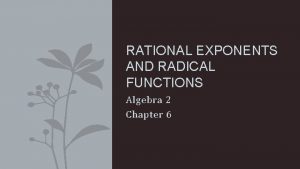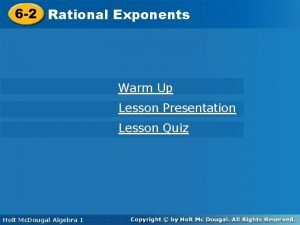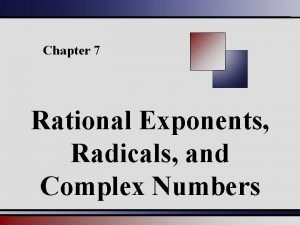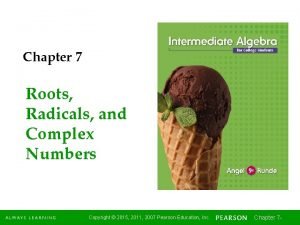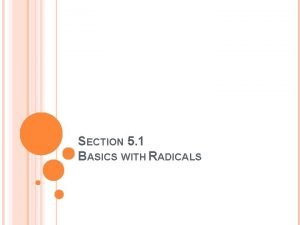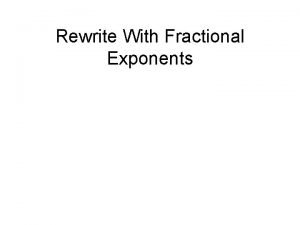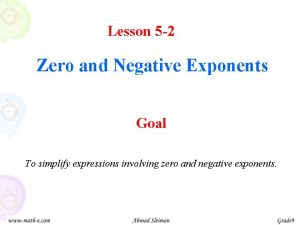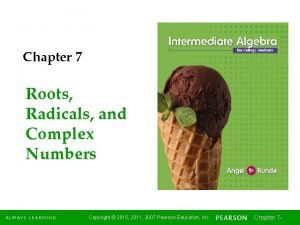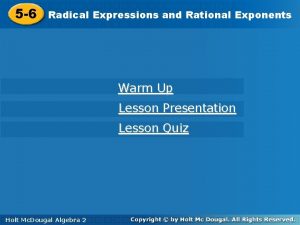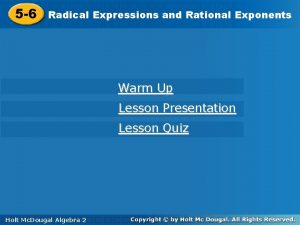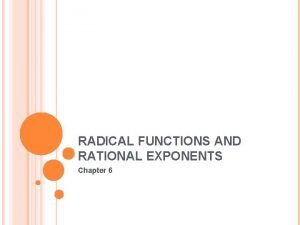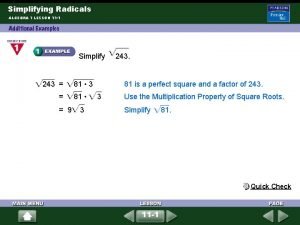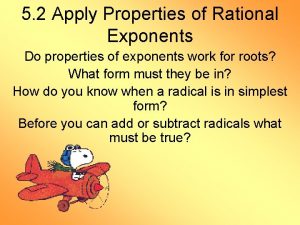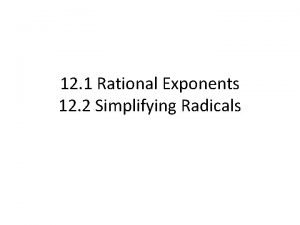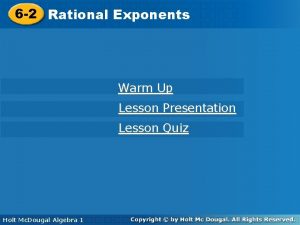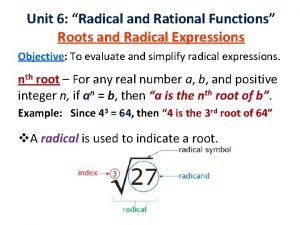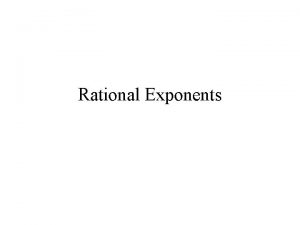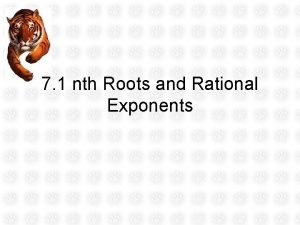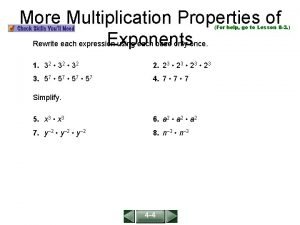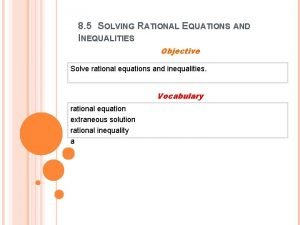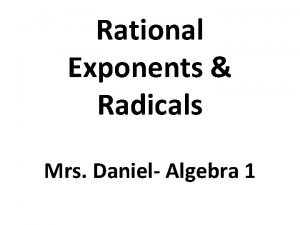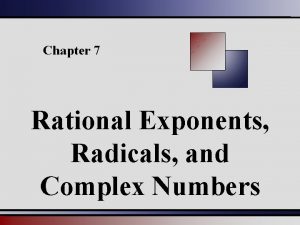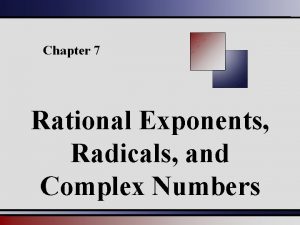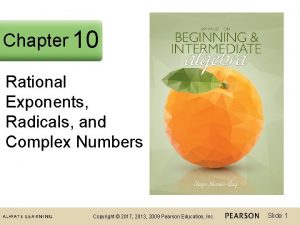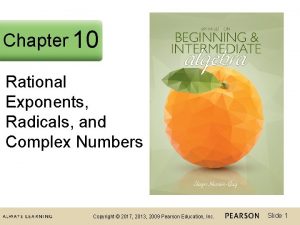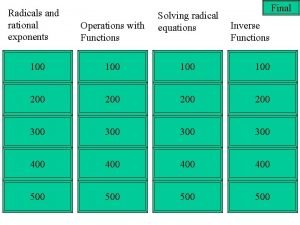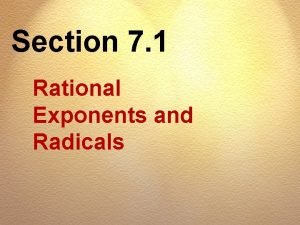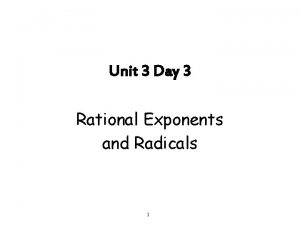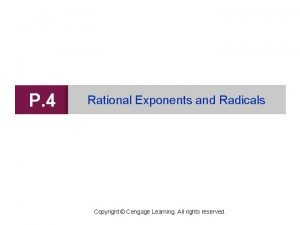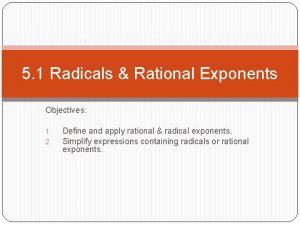Chapter 10 2 Rational Exponents Radicals and Complex
























- Slides: 24

Chapter 10 2 Rational Exponents, Radicals, and Complex Numbers Copyright © 2017, 2013, 2009 Pearson Education, Inc. Slide 1

Section 10. 7 Complex Numbers Copyright © 2017, 2013, 2009 Pearson Education, Inc. Slide 2

Objective 1 Write Square Roots of Negative Numbers in the Form bi. Copyright © 2017, 2013, 2009 Pearson Education, Inc. Slide 3

Imaginary Numbers Previously, when we encountered square roots of negative numbers in solving equations, we would say “no real solution” or “not a real number”. That’s still true. However, we will now introduce a new set of numbers. Imaginary numbers which includes the imaginary unit i. Copyright © 2017, 2013, 2009 Pearson Education, Inc. Slide 4

Imaginary Numbers The imaginary unit, written i, is the number whose square is ‒ 1. That is, Copyright © 2017, 2013, 2009 Pearson Education, Inc. Slide 5

Examples Write using i notation. a. i b. c. i i i Copyright © 2017, 2013, 2009 Pearson Education, Inc. Slide 6

Example Multiply or divide as indicated. a. b. Copyright © 2017, 2013, 2009 Pearson Education, Inc. Slide 7

Standard Form of Complex Numbers A complex number is a number that can be written in the form a + bi where a and b are real numbers. a is a real number and bi would be an imaginary number. If b = 0, a + bi is a real number. If a = 0, a + bi is an imaginary number. Copyright © 2017, 2013, 2009 Pearson Education, Inc. Slide 8

Objective 2 Add or Subtract Complex Numbers. Copyright © 2017, 2013, 2009 Pearson Education, Inc. Slide 9

Adding and Subtracting Complex Numbers Copyright © 2017, 2013, 2009 Pearson Education, Inc. Slide 10

Example Add or subtract as indicated. a. (4 + 6 i) + (3 – 2 i) = (4 + 3) + (6 – 2)i = 7 + 4 i b. (8 + 2 i) – (4 i) = (8 – 0) + (2 – 4)i = 8 – 2 i Copyright © 2017, 2013, 2009 Pearson Education, Inc. Slide 11

Objective 3 Multiply Complex Numbers. Copyright © 2017, 2013, 2009 Pearson Education, Inc. Slide 12

Multiplying Complex Numbers To multiply two complex numbers of the form a + bi, we multiply as though they were binomials. Then we use the relationship i 2 = – 1 to simplify. Copyright © 2017, 2013, 2009 Pearson Education, Inc. Slide 13

Example Multiply: 8 i · 7 i = 56 i 2 = 56( 1) = 56 Copyright © 2017, 2013, 2009 Pearson Education, Inc. Slide 14

Example Multiply. 5 i(4 – 7 i) = 20 i – 35 i 2 = 20 i – 35(– 1) = 20 i + 35 = 35 + 20 i Copyright © 2017, 2013, 2009 Pearson Education, Inc. Slide 15

Example Multiply. (6 – 3 i)(7 + 4 i) = 42 + 24 i – 21 i – 12 i 2 = 42 + 3 i – 12(– 1) = 42 + 3 i + 12 = 54 + 3 i Copyright © 2017, 2013, 2009 Pearson Education, Inc. Slide 16

Objective 4 Divide Complex Numbers. Copyright © 2017, 2013, 2009 Pearson Education, Inc. Slide 17

Complex Conjugate In the previous chapter, when trying to rationalize the denominator of a rational expression containing radicals, we used the conjugate of the denominator. Similarly, to divide complex numbers, we need to use the complex conjugate of the number we are dividing by. Copyright © 2017, 2013, 2009 Pearson Education, Inc. Slide 18

Complex Conjugate The complex numbers a + bi and a – bi are called complex conjugates of each other. (a + bi)(a – bi) = a 2 + b 2 Copyright © 2017, 2013, 2009 Pearson Education, Inc. Slide 19

Example Divide. Copyright © 2017, 2013, 2009 Pearson Education, Inc. Slide 20

Example Divide. Copyright © 2017, 2013, 2009 Pearson Education, Inc. Slide 21

Objective 5 Raise i to Powers. Copyright © 2017, 2013, 2009 Pearson Education, Inc. Slide 22

Patterns of i The powers recycle through each multiple of 4. Copyright © 2017, 2013, 2009 Pearson Education, Inc. Slide 23

Example Find each power of i. a. b. Copyright © 2017, 2013, 2009 Pearson Education, Inc. Slide 24
 Equations with rational exponents
Equations with rational exponents Algebra 2 unit 6 radical functions quiz 6-1 answers
Algebra 2 unit 6 radical functions quiz 6-1 answers How is using exponents helpful
How is using exponents helpful Complex numbers and rational exponents
Complex numbers and rational exponents Examples of like radicals
Examples of like radicals How to convert mixed radicals to entire radicals
How to convert mixed radicals to entire radicals Radical form exponents
Radical form exponents Lesson 5 negative exponents
Lesson 5 negative exponents Complex numbers radicals
Complex numbers radicals Exponents algebra 2
Exponents algebra 2 5-6 radical expressions and rational exponents
5-6 radical expressions and rational exponents 5-6 radical expressions and rational exponents
5-6 radical expressions and rational exponents 6-8 graphing radical functions
6-8 graphing radical functions Practice 11-1 simplifying radicals answers
Practice 11-1 simplifying radicals answers Unit 6 radical functions homework 6 radical equations
Unit 6 radical functions homework 6 radical equations Apply properties of rational exponents
Apply properties of rational exponents Simplify radical 12
Simplify radical 12 6-2 rational exponents
6-2 rational exponents Radical and rational functions
Radical and rational functions Rational exponents
Rational exponents Rational exponents
Rational exponents Evaluating nth roots
Evaluating nth roots Rational exponents
Rational exponents 7-3 more multiplication properties of exponents
7-3 more multiplication properties of exponents 8-5 solving rational equations and inequalities
8-5 solving rational equations and inequalities

